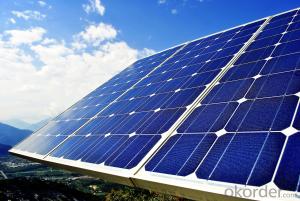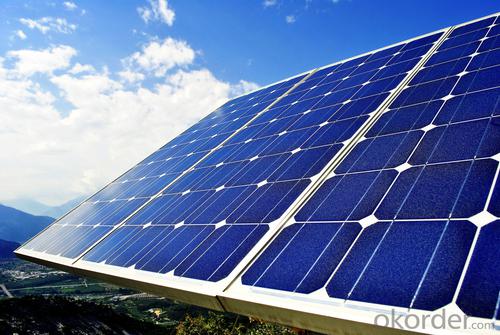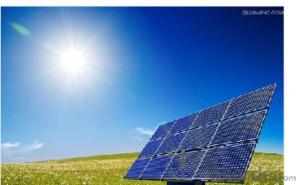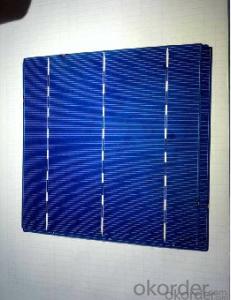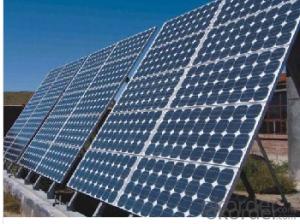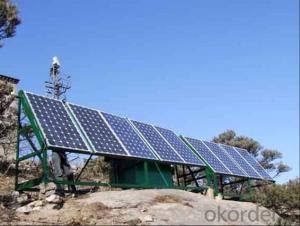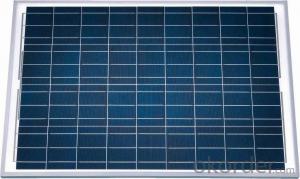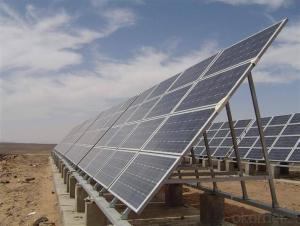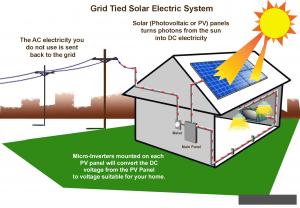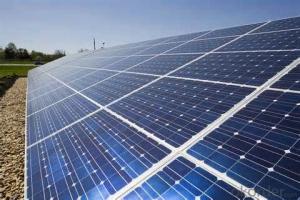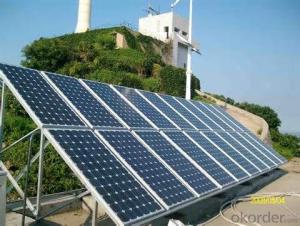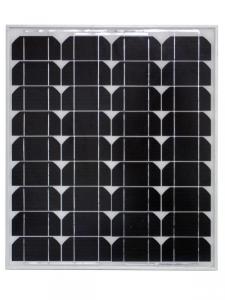Pace Solar Panels 150w Poly Solar Module with High Efficiency
- Loading Port:
- Tianjin
- Payment Terms:
- TT OR LC
- Min Order Qty:
- 1 watt
- Supply Capability:
- 100000 watt/month
OKorder Service Pledge
OKorder Financial Service
You Might Also Like
Specification
Product Description:
1.Structure of Solar Module Description
CNBM Solar's photovoltaic module is designed for designed for large electrical power requirement. It is the optimal choice for both on-grid and off-grid power systems. CNBM Solar offers high performance of power per square foot of solar array.
2.Main Features of the Solar Module
Solar Cell: High efficency crystalline solar cell. Even if under the weak light, the solar module can produce maximum power output.
Tempered glass: Anti-reflecting coating and high transmission rate glass increase the power output and mechanical strength of solar module.
EVA and TPT: Using high quality EVA and TPT to prevent destroying and water.
Strong aluminum frames to strengthen the load hold and to stand against high wind.
Junction box: Multi function junction box with water proof.
Long lifetime: ≥25 years; Less power decrease.
Good performance of preventing from atrocious weather such as wind and hails.
Resisting moisture and etching effectively, not effected by geology.
The certificate issued by international authority: UL, TUV, IEC, VDE, CE.
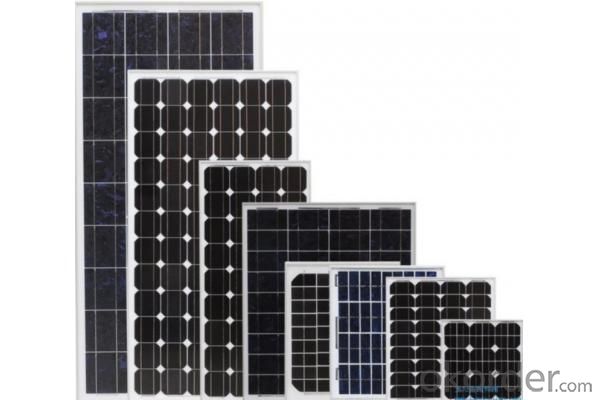
Solar panel working process
In addition to being the ultimate source of all life on earth, the sun is an infinitely renewable, completely pollution-free source of electricity. Instead of burning fossil fuels dug up from the ground in a big power plant – a very 19th century, industrial age approach, when you think about it – solar panels convert sunlight directly into electricity, with no harmful emissions.
The basic unit of a solar panel is a solar cell, which usually consists of one or two layers of silicon-based semiconductor wafers. When struck by the photons in sunlight, the solar cell generates an electrical charge due to the "photovoltaic effect" – which is a pretty good name, since it produces voltage from photons. The flow of these electrons moves in a steady electrical current from one side of the cell to the other.
Dozens of these PV cells are packaged together into solar modules, which in turn are packaged into solar panels that are mounted on a rooftop and arranged to maximize their hours of exposure to direct sunlight. Because the electricity generated by all those solar cells is direct current (DC), it is then sent to an inverter that transforms the power into the same alternating current (AC) used by the appliances in your home and the local utility electricity distribution grid. Increasingly, these inverters are getting "smart," providing data monitoring for solar installation performance and other grid integration services.
- Q: What is the average payback period for solar panels?
- The average payback period for solar panels is typically around 7 to 10 years. However, this can vary depending on factors such as location, system size, local energy rates, and available incentives.
- Q: How much does it cost to replace a solar panel?
- The cost to replace a solar panel can vary depending on factors such as the type, size, and quality of the panel, as well as any additional installation costs. On average, the cost can range from a few hundred to several thousand dollars per panel. It is recommended to consult with a professional solar installer or company for an accurate estimate based on your specific needs.
- Q: Can solar panels generate electricity at night?
- No, solar panels cannot generate electricity at night as they rely on sunlight to convert into electricity.
- Q: Can solar panels be installed on airports?
- Yes, solar panels can be installed on airports. In fact, many airports around the world have already embraced solar energy to meet their power needs and reduce their carbon footprint. These panels are typically installed on rooftops, parking structures, or vacant land within the airport premises. The use of solar panels in airports not only helps generate clean and renewable energy but also contributes to cost savings and long-term sustainability.
- Q: I am looking to buy a solar panel.What does it mean when in the title it says 200 watts, or 50 watts?
- It's okorder / for more details.
- Q: Can solar panels be installed in areas with high levels of air pollution?
- Yes, solar panels can be installed in areas with high levels of air pollution. Although air pollution may slightly reduce the efficiency of solar panels, they can still generate electricity even in polluted environments. Regular maintenance and cleaning of the panels can help mitigate the impact of air pollution on their performance. Additionally, using advanced technologies and materials in the design of solar panels can also enhance their resilience to air pollution.
- Q: Can solar panels be installed on historic buildings?
- Yes, solar panels can be installed on historic buildings. However, the installation process needs to be carefully planned and executed to ensure that it does not damage the historic fabric or compromise the architectural integrity of the building.
- Q: Im doing a science project and I need to know what gases or liquids a solar panel can make that is not friendly to the environment. Please name all the gases and liquids and explain how they damage the environment. It would be most likely that you will get best answer if you find all the bad things about solar energy and explain why they are bad and how they affect nature. that would be helpful to. Thank you
- Once okorder /
- Q: I want to build a standalone wifi repeater -- powered by the sun. The problem is how much solar power and how big of a battery?net draw 4.5v @ 0.66A with loadnet draw 4.5v @ 0.60A no loadI'm assuming the best choice would be a 6v battery with a a couple diodes in series to induce ~.5v drop. Then, I need something to charge it -- I found 2v 6w solar chargers in the automotive section of Sears and 6v 2w solar chargers in the marine section of Dick's Sporting Goods.How many solar panels and what capacity batteries should I use? Is this the best method or should I use a voltage regulator and go with 2v batteries?I need this to be as cheap and simple as possible...
- You won't get very far with THAT lash-up. First of all.. WHY would you want to use diodes to drop the voltage.. they DRAW CURRENT and that is something you don't have to spare. That draw of (660 ma) comes out to just under 3 watts. You DO KNOW that you can get that 4.5 Volts by driving a NAIL into the THIRD CELL in a 6 Volt wet cell battery... right? and for what you are doing, you have more current available with a 6 volt battery than a 2 volt battery. Anyway, you could use two 6 Volt batteries and tap them at the 4.5 volt point then tie them in parallel, but you could still use the 6 volt solar panel to charge them. Trying to use an inverter is just an exercise in futility.. With TWO of the LARGEST DEEP CYCLE BATTERIES you can buy at AutoZone running in Parallel and being charged by solar panels.. if you hook a 75 watt inverter to them, they will go flat in about 4 hours of use during the night. This is not rocket science. Back when cars were changing over from 6 volts to 2 volts, I powered up more than one 6 volt car radio off a 2 volt battery... when you grow up as poor as I did.. you get inventive. I later used the same trick on the 24 volt electrical systems the Jeeps were using, to power up clandestine repeaters in places where no repeaters should have been. About 25 years ago I was living in the Denver area and built up a 0 watt 2 meter repeater on a split channel and took it up to Mt. Evans during the summer and hid it in a pile of rocks. I used tone control, so we were the only ones using it and, as I said, It was a split channel.. so it wasn't on a regular repeater channel. That thing was still running when I moved from the Denver area about 3 years later and for all I know, It's still up there on Mt. Evans (find the Brittlecone Pines and look towards that small peak about a mile to the west)
- Q: hi everyone..i wanna do my major project on solar panels...so anyone kindly tell me the projects based on solar panels..
- I have done this in my project too and a solar panel, two wires, a circuit/project board, an LED light/a small fan,a switch and a solderer. Just solder the wires to the positive and negative parts of the panel, put the wires connected to the panel to the board put the LED's on the other side and the switch together with it shine light on the panel and the light/fan will work.(If it dosen't work, please DO NOT consult ME.)
Send your message to us
Pace Solar Panels 150w Poly Solar Module with High Efficiency
- Loading Port:
- Tianjin
- Payment Terms:
- TT OR LC
- Min Order Qty:
- 1 watt
- Supply Capability:
- 100000 watt/month
OKorder Service Pledge
OKorder Financial Service
Similar products
Hot products
Hot Searches
Related keywords
